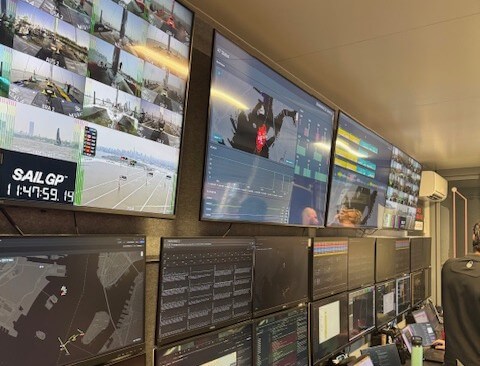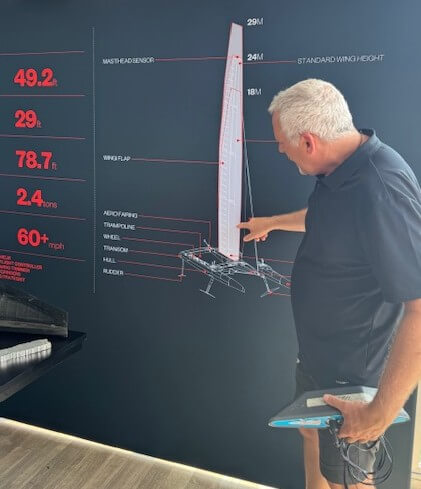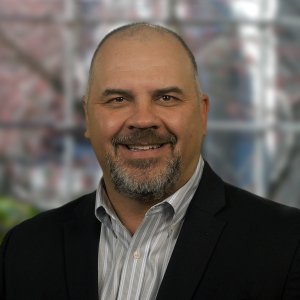SailGP, often described as Formula 1 on water, is rapidly becoming a case study in how cutting-edge communications infrastructure can redefine what’s possible in competitive sports. At the heart of this transformation is the deployment of private 5G networks. While this technology may not be typically associated with sailing, it is now indispensable to this data-driven sport.
SailGP utilizes private 5G to ensure seamless telemetry, real-time analytics, global broadcast, and operational efficiency in some of the most challenging and dynamic environments in sport. I had the opportunity to attend a recent race to see how the technology worked in person.

5G at Sea: Delivering Speed, Scale and Reliability
The SailGP fleet comprises ten 50-foot high-tech foiling catamarans, known as F50s, which are piloted by ten different international teams. They are based on the AC50 catamarans used in the 2017 America’s Cup and can reach speeds exceeding 100 km/h. As impressive as the physical performance is, it’s the digital backbone behind the scenes that fuels these races. The private 5G infrastructure is enabling the next generation of sailing competition.
Everything aboard these vessels is wireless. Traditional wiring proved infeasible due to the extreme conditions and constant motion. Instead, SailGP collaborated with Ericsson (Cradlepoint) to develop a ruggedized, dual-modem system that aggregates multiple 5G links—both private and public—bonding them for enhanced reliability and speed. The Ericsson Cradlepoint Wireless WAN routers are not only used on catamarans but also on autonomous buoys that define the course and can be moved as needed.
Antennas are embedded inside the wing sails and mounted within pods at the hull, ensuring redundancy even if a boat capsizes. The system ensures uninterrupted connectivity to shoreside containerized data centers, where data is instantly streamed and analyzed, often with a latency of less than 100 milliseconds.

Mobile Edge and Remote Operations
Unlike fixed stadiums or arenas, SailGP operates across a dozen different international venues per season, with multiple sites across the Middle East, Australia, the US (I attended an event at Liberty State Park in New Jersey), and Europe. Each site presents unique RF and logistical challenges, often without permanent infrastructure.
To overcome this, SailGP deploys private 5G radio units and mobile network cores at each venue. These networks are extended with network slicing from public providers like T-Mobile (in the US) and BT (in the UK), effectively blending private and public resources to ensure uninterrupted coverage across both the racetrack and team areas.
Critically, this setup supports full remote operations. Race directors, analysts, and broadcasters don’t even need to be on-site. Entire production teams operate from central facilities, like London, relying on cloud infrastructure to manage real-time feeds, issue commands, and run AI-based analytics. In one example we heard during our tour, New Zealand’s team director communicated directly with sailors from his home during a live race, illustrating the power of distributed, 5G-enabled operations.
Telemetry and Analytics at Scale
Each F50 boat generates an astounding 3,500 telemetry data points per second, per boat, with over 10 times that amount logged locally. These include metrics like wing camber, foil position, hydraulic pressure, GPS location, and crew input. Data is streamed in real-time over 5G to onshore containerized data centers and cloud environments, where it’s processed and visualized for teams, coaches, and race management.
AI and machine learning models play a growing role in filtering, pattern recognition, and anomaly detection. This includes early warning signs of mechanical failure, flight stability analysis, and optimal path prediction based on wind patterns. The use of digital twins and simulators allows new teams to train effectively and quickly become competitive, as evidenced by Canada’s rapid ascent in their first season after studying shared league data.
A Democratized Data Model
One of SailGP’s most innovative elements is its open data model. All telemetry, performance metrics, and video feeds are shared equally across all teams. There is no proprietary tech edge—only execution. Each team has access to real-time data not only from their own boats but from every competitor.
This has created a unique dynamic in the sport: instead of developing secretive advantages, teams focus on refining technique, simulation, and in-race decision-making. Some teams go a step further, building their own in-house data pipelines and AI-enhanced analytics platforms to draw deeper insights.
The results speak for themselves. Real-time feedback allows coaches to adjust tactics mid-race. Strategists analyze wind patterns and pressure zones with precision. And athletes continuously refine their understanding of optimal flight height and foil angle to gain every advantage in the races.
Redundancy, Resilience and Broadcast Quality
In a marine environment, reliability isn’t a luxury—it’s mandatory. That’s why SailGP’s network architecture includes multiple failover mechanisms: dual-modem configurations, bonded 5G links, and public/private slicing. Even in the event of a capsize, connectivity is preserved via secondary hull-mounted antennas, ensuring uninterrupted data flow, comms, and video. As a side note, the ruggedized modems from Ericsson have withstood the harsh saltwater environments very well, even when submerged for extended periods, showing no signs of corrosion.

This robustness extends to the sport’s broadcast strategy. 5G-connected onboard cameras stream real-time, high-definition video from multiple angles: on the wing, from the bow, and at the helm. Some video feeds are transmitted over the private 5G network, similar to what we saw in the opening parade of the Paris Olympics, with two notable distinctions: one, SailGP operates offshore, and two, the boats are traveling at speeds of 60 miles per hour or more. All of it is bonded and synchronized in real time to support live streaming and replay analysis.
Cloud-centric Workflow and Sustainability
SailGP’s operational philosophy prioritizes minimal on-site equipment and personnel. The entire event infrastructure is designed to be lightweight, mobile, and sustainable. Solar panels power key systems aboard the boats. Batteries charge between races. Human power, via “grinders” (crew members who manually operate winches), is used to adjust the wing and foil systems.
By moving computation and decision-making to the cloud, SailGP reduces the environmental footprint while increasing agility. This enables fast setups and takedowns across global venues, supporting the league’s broader sustainability goals.
OurANGLE
SailGP is an excellent example of what’s possible when elite sport meets enterprise-grade networking. The fusion of private 5G, AI, and cloud infrastructure is transforming sailing from an analog pastime into a digital proving ground for next-gen connectivity. As enterprises look to adopt private networks and mobile edge computing, they would do well to study how SailGP, in partnership with Ericsson and Mobile Network Operators such as T-Mobile and BT, obtains real-time insights from a highly dynamic environment taking place on the open seas.
SailGP’s investment in this infrastructure not only enhances the visibility of racing but also serves as a living lab for 5G innovation under extreme conditions. The fact that the entire environment is highly portable should be attractive to industries that operate in remote locations for limited periods.
Make sure to check out the next SailGP event and see how 5G technology is transforming the sport of sailing.
Calendar – SailGP 2025 Season Schedule, Race Listing and Venues
And for more information on how Ericsson Private 5G solutions can power your environment, click on the link below
Ericsson Private 5G – Private network for your industry
To watch the Mobile World Congress video with SailGP CTO Warren Jones and Jonathan Fischer of Ericssion click below
Warren Jones, Sail GP & Jonathan Fischer, Ericsson | MWC25 Barcelona.mp4



